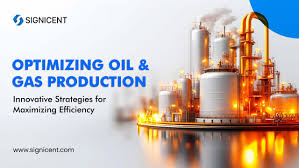Efficient oil and gas production has never been more crucial. With growing global energy demands and the increasing need to minimize environmental impacts, the industry must adopt practices that enhance productivity while preserving natural resources. From advanced technology to operational optimization, maximizing efficiency depends on various factors. Here’s an in-depth look at how efficiency can be improved across the oil and gas sector.
1. Leveraging Advanced Technologies
Automation and AI Integration
Automation has become a game changer in oil and gas production. By leveraging artificial intelligence (AI), companies can improve decision-making processes, predict equipment failures, and analyze operational efficiencies in real time. Smart systems allow for precise management of resources, reducing waste and downtimes.
For instance, AI-powered sensors can monitor equipment performance continuously. They provide alerts when maintenance is needed, limiting disruptions and avoiding catastrophic failures. Such predictive maintenance helps increase longevity and productivity.
Advanced Drilling Techniques
Horizontal drilling and hydraulic fracturing have revolutionized the way hydrocarbons are extracted. These techniques allow access to previously unreachable reserves, dramatically improving yields. Additionally, modern rigs equipped with automation features enhance drilling speed and accuracy while maintaining safety standards.
2. Optimizing Production Processes
Data-Driven Operations
Data analytics plays a key role in enhancing operational efficiency. Utilizing big data enables companies to identify trends, spot inefficiencies, and optimize production plans. Real-time data tracking also aids decision-making by offering insights that adjust operations dynamically.
For example, dynamic field modeling uses historical and current data to evaluate performance and predict future outcomes. This ensures resources are allocated in the most efficient way possible across the entire value chain.
Streamlined Equipment Maintenance
Maintaining equipment regularly is essential to prevent downtime. One innovative approach to equipment optimization involves techniques like cylinder honing, which restores accuracy and strength to key mechanical parts. By ensuring engine and machinery components perform at their best, operations run more smoothly, cutting costs and elevating efficiency.
3. Reducing Energy Waste
Upgraded Infrastructure
Outdated infrastructure leads to inefficiencies and higher energy consumption. Retrofitting production sites with modern systems, such as energy-efficient compressors and pumps, reduces overheads and minimizes resource wastage. Many facilities now upgrade to heat recovery systems, which repurpose excess heat for other operations.
Renewable and Hybrid Integration
The oil and gas sector is increasingly incorporating renewable energy solutions into their operations. Solar panels and wind farms can provide supplementary power to extraction processes, minimizing dependence on traditional fuels. Hybrid systems have the added advantage of reducing environmental footprints while lowering overall energy costs.
4. Focusing on Sustainability
Minimizing Methane Leaks
Methane emissions have long been a significant issue for the industry. New leak-detection systems, such as infrared imaging and drone technology, have made it much easier to locate and address methane leaks efficiently. By tackling these leaks promptly, companies not only enhance production efficiency but also reduce harmful emissions.
Water Recycling Efforts
Water usage is another critical area where improvements can make a substantial difference. Recycling and reusing water in extraction and fracking processes not only conserve resources but also mitigate operational expenses. By investing in water treatment facilities, companies can ensure a sustainable supply for their activities.
5. Enhancing Workforce Efficiency
Training and Development
The role of an educated workforce cannot be undermined in achieving operational excellence. Regular training programs ensure employees understand and adopt the latest technologies and practices. Skilled personnel can operate equipment more effectively, reducing errors and enhancing outcomes.
Collaborative Workflows
Efficient communication and collaboration among teams enhance decision-making and task execution. Cross-departmental workflows that encourage knowledge sharing make operations more synchronized and less prone to inefficiencies. Digital tools, such as shared platforms and cloud-based systems, aid in connecting remote teams for seamless operation management.
6. Regulatory Compliance and Risk Management
Meeting Safety Standards
Following stringent safety standards is not only ethical but also vital for uninterrupted operations. Regular audits, safety drills, and compliance monitoring reduce the risk of workplace incidents. Safer working environments also contribute to higher morale among employees, indirectly boosting productivity.
Risk Assessment and Preparedness
Effective risk management minimizes downtime. Comprehensive risk assessments should account for equipment failure, natural disasters, and market fluctuations. Incorporating contingency plans ensures uninterrupted production when faced with unforeseen circumstances.
7. The Role of Innovation in the Future
The oil and gas industry is constantly evolving. Technologies such as carbon capture, utilization, and storage (CCUS) and digital twin simulations offer future-forward solutions to current inefficiencies. By adopting innovations early, companies can gain a competitive edge and meet growing energy demands responsibly.
Conclusion
Achieving maximum efficiency in oil and gas production requires a multifaceted approach. From deploying cutting-edge technology to sustaining workforce excellence and focusing on sustainability, every step counts. By continuously assessing operations and adopting innovative solutions, the industry can balance profitability, reliability, and environmental stewardship effectively.
